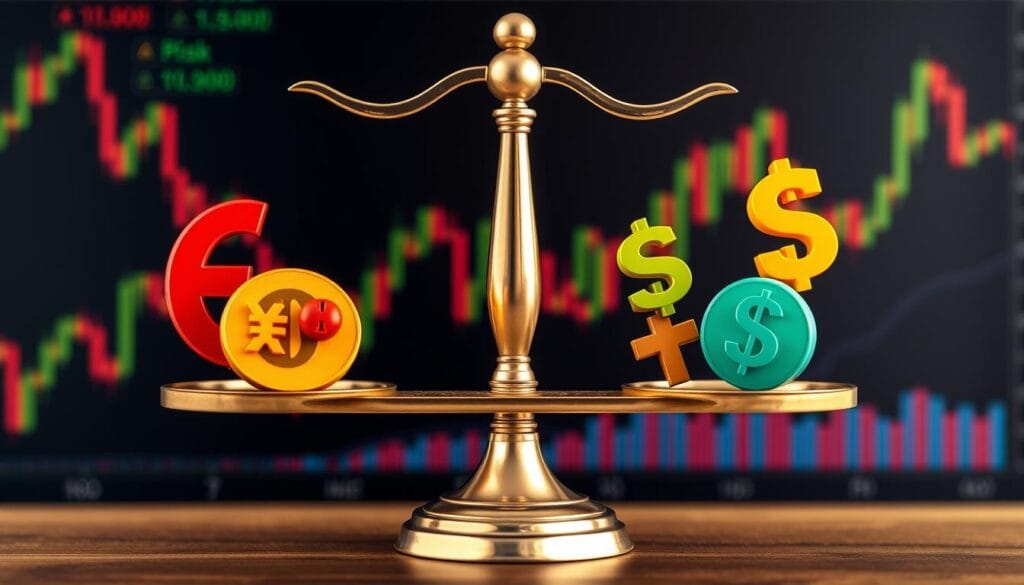Forex risk management is crucial in the quick-moving world of currency trading. It helps traders protect their investments. The market is volatile; wrong moves can cause big losses.
To guard your portfolio, it's important to use trading strategies with strong risk management. This guide covers essential concepts and practical methods. It shows how good risk management can make trading safer and more profitable.
Key Takeaways
- Forex risk management is essential for safeguarding investments.
- Understanding market volatility can help mitigate risks.
- Effective trading strategies focus on maximizing profits while minimizing losses.
- Leverage can amplify both gains and risks in currency trading.
- Implementing tailored risk strategies is crucial for long-term success.
The Importance of Risk Management in Forex Trading
Risk management is key in Forex trading, helping to guard investments. It means understanding market changes. These changes can greatly impact prices.
Understanding Market Volatility
The Forex market sees unpredictable shifts due to many factors. These include global events, economic news, and central banks' decisions. Traders must smartly navigate these to minimize losses. Knowing how market changes affect trading is crucial for good decisions and strategy adjustments.
The Impact of Leverage on Risk
Leverage in Forex can increase wins and losses, making its management vital. It's important for traders to get how leverage affects risk. High leverage can lead to big profits or losses. This raises the risk level. Understanding leverage helps traders manage risk better while aiming to grow their trading success.
Key Concepts of Forex Risk Management
Forex trading risks can be managed better by understanding key concepts. The risk-reward ratio and position sizing are vital. They are crucial for a strong Forex trading strategy, helping in capital management.
Risk-Reward Ratio Explained
The risk-reward ratio is key for traders to evaluate trades. It compares potential profit to potential loss. For example, a 1:3 risk-reward ratio means you could make three dollars for every dollar risked. This ratio helps traders decide if a trade fits their goals and manage risk well.
Understanding this ratio lets traders make smarter choices. It encourages a disciplined way to handle capital.
Position Sizing Strategies
Position sizing means choosing how much currency to trade, based on risk tolerance and capital. It's key to controlling exposure and limiting losses. For instance, traders might risk a set percentage of their capital on a trade.
Adjusting position sizes helps improve the risk-reward ratio, aiding in Forex success. Good position sizing strategies lead to structured and disciplined trading.

Mastering Forex Risk Management
Effective risk management is key for Forex traders. To safeguard investments, using the right trading tools and techniques is vital. Knowing how to use these tools helps traders stay disciplined and limit losses.
Tools and Techniques for Effective Management
Traders have several tools to manage risks. These options include:
- Automated Trading Platforms: They allow for trades to happen based on set conditions, which helps remove emotions from trading decisions.
- Stop-Loss Orders: This important feature closes a trade at specific price levels automatically. It helps to minimize losses when the market moves against you.
- Risk Management Calculators: These calculators aid in deciding how big a position should be. They consider your account balance and how much risk you're willing to take.

Common Mistakes to Avoid
Identifying and steering clear of common Forex errors can lead to better trading results. Traders often stumble by:
- Over-Leveraging: Using too much leverage increases risk and potential loss. It's crucial to keep leverage at a manageable level for success.
- Emotional Trading: When emotions guide trading, it can lead to hasty decisions that stray from the plan.
- Neglecting to Use Stop-Loss Orders: Not setting stop-loss orders opens the door to big losses, hurting confidence and accounts.
By being aware of these traps, traders can boost their discipline and make better decisions. A solid understanding of risk management techniques prepares traders for Forex market complexities.
Developing a Risk Management Plan
Creating a risk management plan is essential for trading success. It aligns your trading with financial goals and promotes discipline. You can track your progress and adjust your approach with effective goal-setting.
Setting Your Trading Goals
Setting clear goals is key in your risk management plan. Apply the SMART criteria—specific, measurable, achievable, relevant, time-bound. This helps in making realistic Forex objectives that match your risk comfort and trading style.
To make your goal-setting stronger, consider these points:
- Define specific targets for profit and loss.
- Establish a timeline for achieving each goal.
- Regularly review and adjust goals based on trading performance.
- Ensure that your goals align with your personal risk management approach.

Writing down your goals helps track your trading progress. Adding various strategies, like setting stop-loss levels, improves discipline. This leads to a proactive Forex trading attitude and wiser decisions.
| Goal Type | Description | Timeframe |
|---|---|---|
| Profit Target | Aim for a specific dollar amount or percentage return. | Monthly |
| Loss Limit | Set a maximum loss per trade to mitigate risk. | Per Trade |
| Diversification | Invest in multiple currency pairs to spread risk. | Ongoing |
| Performance Review | Regularly assess trading results to understand effectiveness. | Weekly |
This approach leads to a solid risk management plan, increasing your Forex success chances. Regular reviews help you stay aligned with market changes and your trading goals.
Conclusion
Mastering Forex risk management is key for anyone looking to succeed in trading. We've touched on vital points like market volatility and leverage. Understanding these can really protect your trading strategy.
Effective risk management means analyzing important factors. It involves figuring out risk-reward ratios and how big your trades should be. This helps in protecting your investment.
To stay safe in the ever-changing Forex market, traders need to use strong tools and strategies. It's also important to keep learning. This way, you can keep getting better at managing risks.
The path to being a successful trader involves disciplined risk management. Use the tips we've talked about and always be proactive. This can hugely boost your chances of making it big in Forex trading.













